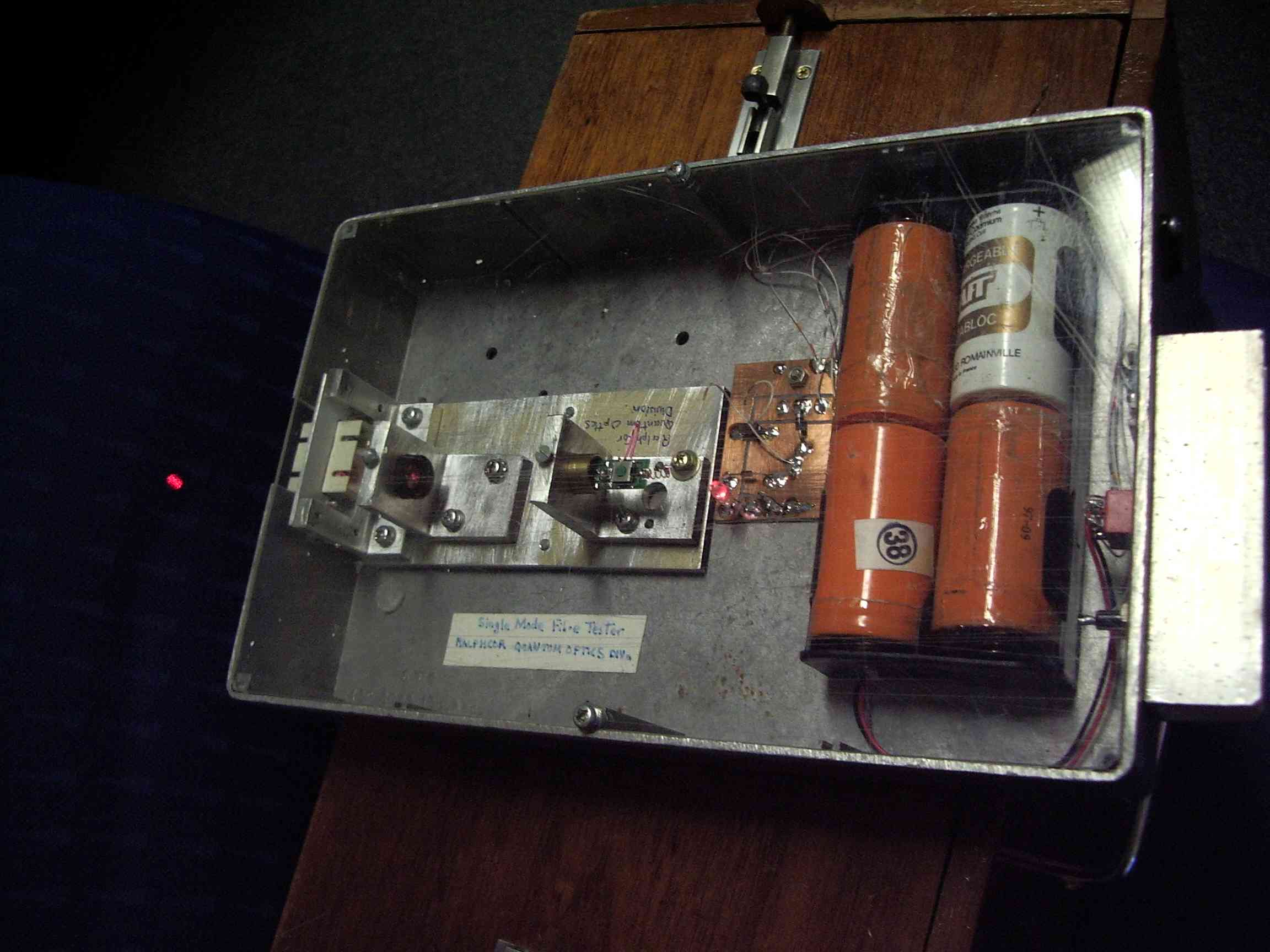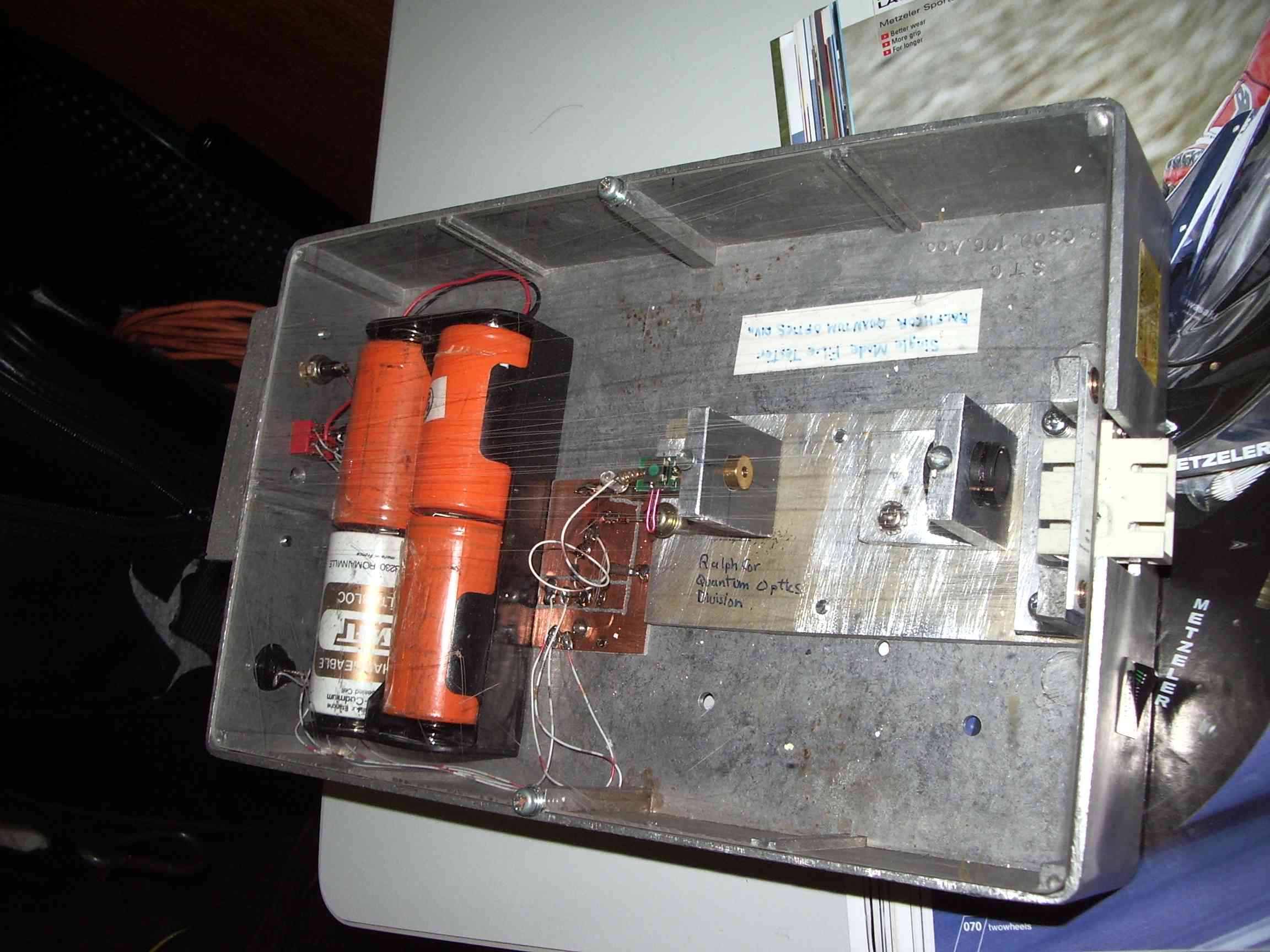single mode laser tester
for testing single mode 9um communication fibres
by Ralph Klimek 2003
The usage by Monash of 9um single mode communication fibres required me
to find some simple ways of testing patch leads and wired installations
as well as small hop fibre wan paths both for commissioning fibre paths
and debugging paths that were broken, in the absence of any possibility
of sourcing an OTDR.
Multimode fibre installations and patch leads may be tested with
nothing more than a simple torch, even holding a multimode fibre up to
the light will couple sufficient energy down a 200 meter path to a
person at the far to quickly verify continuity. This simple
technique works well with 62.5 micron fibres, less well with 50 micron
fibre but completely fails with 9um single mode fibre due to its small
angle of acceptance and very small aperture. A hi intensity red
LED will just barely couple enough optical power to be visible down a
100 meter length , visible, that is, with dark adapted eyes in a dark
room. This is exactly the situation that you want to avoid given that
communication fibres might be expected to carry up to 20mW of optical
power.
I bought the inards of a red laser pointer from Jaycar and tried that.
An unmodified laser pointer will inject sufficient light to give a
directly visible red spot at the end of a 10 meter patch lead, but
still not enough for anything really long. The laser pointer
output beam is neither very circular and is not well collimated, this
is deliberate, this is done for safety. I found a projection lens
from a discarded HP scanner and mounted it to focus down onto the input
aperture of the fibre ferrule.
First, I obtained a rought measurement of the focal length of the lens.
Mountings were constructed by hand and some quarter inch aluminium
plate served as the optical bench. Adjustment was performed with shim
stock and the mounting screws which permit some pitch and yaw
adjustment.
For final alignment a fibre light power meter was used to align the SC
feedthrough connector. My primitive optics couple something like 100
microwatts of power into the fibre which is sufficient for
testing 4 kms of fibre. I have tried this with some of
Monash's longer WAN leased fibre runs but due to the exponential
increase in loss, anything over 5 kms becomes invisible.
The unit has proved itself usefull many times in resolving mislabled
fibre frame issues and verifying broken paths, faulty patch leads and
fully testing complete fibre paths before use. Battery life, which are
in this case some old 4ah NiCds is several days of continuous on time.
The total project cost was $15 for the the laser and $2 for the battery holder. Everything else was recovered from the junk box.
Suitable lenses could be obtained from discarded micro fiche readers or dead scanners.
The little pcb containers nothing more than a led pilot light, a
reverse polarity protection diode and an overvoltage protection zener.
Lasers are static sensitive and I thought this extra protection was
warranted. The on off switch of the laser pointer module has been
bypassed. The laser pointer module contains some electronics to
stabilise the laser diode current and hold it in its lasing operating
point. I have not attempted to biuld my own laser diode servo as this
is a bit of a black art. Typical laser diodes run at 90% of the
current density required to destroy them. Below this current they will
not lase.
Equivalent commercial single mode illuminators used to cost about $4000 when I built this device.
The 100 microwatt output is defineately unpleaseant but it is eye
safe. If there is no fibre plugged into the holder , the beam at
this point is no longer collimated and expands quickly to harmless
intensity.
The nice wooden box I found in a skip, now serves as home for the
tester and collection of patch leads and testing nick nacks. The angle
stock at the back of the unit protects the on off switch from
accidental activation when its being transported.
homepage
modrecord
fixed formatting , email sig Tue Nov 24 18:18:27 EST 2009


